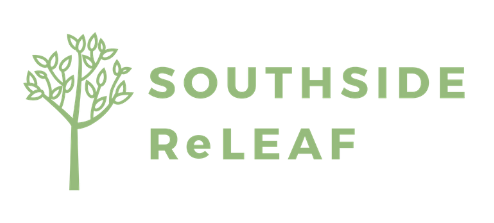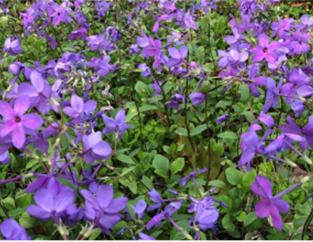Plant Selection at Ernest Road: Wildflowers
White Wood Aster (Eurybia divaricata)
Woodland aster, is a native herbaceous perennial in the Asteraceae (daisy) family. Native to the Eastern United States this wildflower typically grows in dry open woodlands, primarily in Appalachian mountain areas. It is shade, deer, and drought tolerant. The showy white flowers appear in clusters dancing above the heart shaped leaves in late summer to fall and are a favorite of bees and butterflies. The seeds that follow the flower are eaten by birds and small mammals and provide a valuable fall and winter food source. The center of the flowers (disk flowers) change from yellow to red upon pollination.
White Wood Aster Overview
White Wood Aster Flowers
White Wood Aster Leaves
White Wood Aster Stem
Wreath Goldenrod (Solidago caesia)
Wreath Goldenrod is a Wildflower in the Asteraceae family. It is an herbaceous perennial that grows 3 feet tall with showy clusters of yellow flowers that hug greenish-purple stems in the summer and early fall. This plant supports Wavylined Emerald (Synchlora aerata) larvae. Flowers are attractive to butterflies, bees, and other pollinators. Songbirds eat the seeds. Goldenrods have been wrongfully accused of causing hay fever which is actually an allergic reaction to wind-borne pollen from other plants such as ragweed.
Wreath Goldenrod Overview
Wreath Goldenrod Flowers
Wreath Goldenrod Leaves
Wreath Goldenrod Stem
Zigzag Goldenrod (Solidago flexicaulis)
This woodland goldenrod, with erect, somewhat zig-zag stems, bears small flower heads on short axillary stalks from the upper leaves. The plant is 8-48 in. tall with pointed, alternate, oval leaves that are coarsely toothed. Flowers bloom from mid-summer to fall and are attractive to bees and butterflies. Genus name comes from the Latin words solidus meaning whole and ago meaning to make in reference to the medicinal healing properties of some species plants. One may notice that this looks very similar to the Wreath Goldenrod. Key differences can be seen in the leaf shape and the growth pattern. This species stands straight up more and can have larger leaves.
Zigzag Goldenrod Overview
Zigzag Goldenrod Flowers
Zigzag Goldenrod Leaves
Zigzag Goldenrod Stem
Blue Wood Aster (Symphyotrichum cordifolium)
Blue Wood Aster is a herbaceous perennial that may grow 3 feet tall. It has narrow, alternate leaves with a toothed margin. Pale blue to violet flowers bloom in large, loose panicles. A low maintenance perennial native to eastern and central North America the blue wood aster is commonly found naturalized in woodlands, meadows, or stream banks. It self-seeds very easily, which makes it a good cover species. It is a host plant for the Pearl Crescent butterfly. Flowers are attractive to bees and butterflies. Songbirds and small mammals eat the seeds.
Blue Wood Aster Overview
Blue Wood Aster Flowers
Blue Wood Aster Leaves and Stems
Blue Wood Aster Overview
Wild Geranium (Geranium maculatum)
Wild geranium is a woodland perennial flower in the Geraniaceae family that will naturalize in optimum growing conditions. It is easy to grow in cultivation and is one of the showiest of the native Cranesbills. The attractive deeply lobed leaves are topped by saucer-shaped flowers that are pink to lilac in spring. Use in mass as a ground cover, in woodland settings or native and pollinator gardens. This plant is clump-forming. Medicinally used by Native Americans to treat diarrhea and open sores or wounds. Nectar from flowers attracts butterflies, bees and other pollinators. Songbirds eat the seeds. This plant tolerates damage by deer and rabbits.
Wild Geranium Overview
Wild Geranium Flowers
Wild Geranium Leaves
Wild Geranium Fall Leaves
Eastern Columbine (Aquilegia canadensis)
Eastern columbine is a native herbaceous perennial in the Ranunculaceae (buttercup) family. The genus name Aquilegia is derived from the Latin word for eagle as spurs at the back of the flower petals resemble an eagle’s claw. The red and yellow flowers mature in early spring and can last one month. These tubular flowers attract hummingbirds, butterflies, and bumblebees. Once the flowers are gone the plant makes an attractive ground cover. Columbine freely self seeds, and new plants will bloom the second year. This plant is deer resistant. 5 pod-shaped follicles with long beaks that split open along one side to release the shiny black seeds. Displays from April to August.
Eastern Columbine Overview
Eastern Columbine Flowers
Eastern Columbine Leaves
Eastern Columbine Winter Leaves
Foamflower (Tiarella cordifolia)
Foamflower is a small, delicate native herbaceous perennial flower grown in gardens for its neat, interesting foliage and small spikes of creamy white flowers. Despite its slow growth rate, Foamflower can be used as a groundcover as it spreads by underground rhizomes. Narrow cluster of dainty small white-to-pink flowers on the upper portion of a leafless stalk floating above the leaves; five small petals that taper into stalked bases. Blooms in early spring (April-June).
Foamflower Overview
Foamflower Flowers
Foamflower Leaves
Foamflower Overview
Coral Bells (Heuchera americana)
Coral bells is a small, mounding herbaceous perennial in the Saxifragaceae family with attractive foliage color. It has fibrous roots and a mounded rosette of attractive foliage highlighted with colorful veins or marbling. The leaves emerge in a dense spiral from a short central crown and can be green or variegated in shades of purple, bronze or cream. Flower panicles emerge in the spring on leafless stalks above the foliage. The individual tiny flowers are bell-shaped with extended stamens and are greenish or creamy with a pinkish tint. Heucheras are drought tolerant and work well planted in small groups in the front of a border and along pathways.
Coral Bells Overview
Coral Bells Flowers
Coral Bells Leaves
Coral Bells Overview
White Snakeroot (Ageratina altissima)
White Snakeroot is a herbaceous perennial that can grow to 3 feet. The plant is native to woodland areas in the Eastern United States and typically occurs in rich or rocky woods, thickets, wood margins, and rocky areas. This is one of the last wildflowers to bloom during the fall. The root system consists of spreading rhizomes and shallow fibrous roots. This plant can spread by means of its rhizomes, or it can reseed itself into new areas. This is one of the last wildflowers to bloom during the fall. Reportedly, the erroneous belief that an extract of the roots was a remedy for snakebite led to the common name.
White Snakeroot Overview
White Snakeroot Flowers
White Snakeroot Leaves
White Snakeroot Overview
Golden Ragwort (Packera aurea)
Golden ragwort is a native perennial in the Asteraceae (daisy) family. It is found growing in forests, swamps, ravines, or riparian areas in eastern North America to Texas as an herbaceous flowering plant. It forms thick spreading mats and in the spring it sends up stalks of bright yellow flowers that attract many pollinators. The blooms will even appear in the shade adding some much needed brightness to darker spots in the landscape. The flowers can look unkempt after they die so cut them down to the leafy base of the plant or leave the seeds for birds. Allow it to naturalize in the landscape, use as a ground cover in shady wet areas, or along a border, in a bog, butterfly, or rain garden.
Golden Ragwort Overview
Golden Ragwort Flowers
Golden Ragwort Leaves
Golden Ragwort Leaves
Blue Phlox (Phlox divaricata)
Blue phlox is a native herbaceous perennial wildflower in the Polemoniaceae family that may grow 6 to 12 inches high. Clumping or spreading horizontally it is often found growing on the forest floors in eastern North America. Plant in partial to full shade in moist high organic material well-drained soils. The leaves are opposite with a smooth margin. Fine hairs extend from the leaf margin. The stem is both hairy and sticky. Rose, lavender or violet-blue fragrant flowers first mature in spring and continue into early summer. The showy flowers attract pollinators making it an excellent addition to a butterfly bee garden. It is also an effective, shallow-rooted cover for early spring bulbs.
Blue Phlox Overview
Blue Phlox Flowers
Blue Phlox Leaves and Stem
Blue Phlox Overview
Golden Alexander (Zizia aurea)
Golden Alexanders is a carefree plant found in small colonies on wet soils but is also tolerant of dry summer conditions. It thrives in full to partial sun, but also grows in light shade under trees. Moist, well-drained soil is best, but this very adaptable plant will tolerate both wet conditions and dry conditions, as long as there is plenty of moisture early in the growing season. This plant is a host for the Black Swallowtail and the Ozark Swallowtail.
Golden Alexander Overview
Golden Alexander Flowers
Golden Alexander Leaves
Golden Alexander Overview
Thimbleweed (Anemone virginiana)
Tall anemone is a herbaceous perennial in the buttercup (Ranunculaceae) family that is native to Canada and central to eastern USA. The genus name is said to be derived from the Greek word “anemos” meaning “wind”. Tall anemone prefers moist, humusy sandy soil and tolerates full shade but prefers some sun. The whitish flowers appear in late spring to early summer with a thimble-like center. This center elongates forming tall thimble-like fruits that eventually become cottony with white hairs. that persists into winter. This plant is resistant to damage by deer and rabbits. The sap may cause skin irritation so wear gloves to prune.
Thimbleweed Overview
Thimbleweed Flowers
Thimbleweed Leaves
Thimbleweed Overview




















































